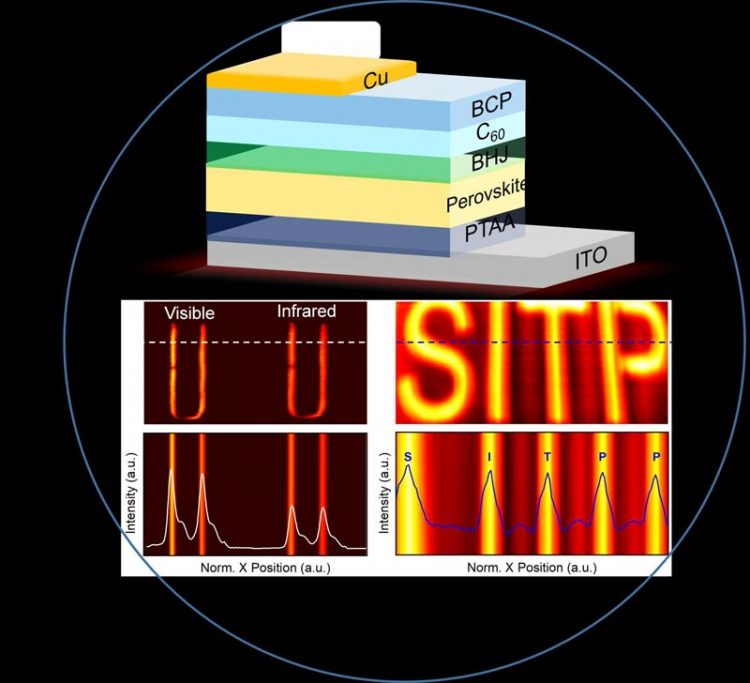Ultrafast and broadband perovskite photodetectors for large-dynamic-range imaging

OIHP photodetectors for Visible and NIR (with an 830-nm long-pass filter) imaging, as well as imaging of SITP (an abbreviation of Shanghai Institute of Technology and Physics) letter graphics under LED illumination. The white and blue lines in the figure represent the normalized photocurrent signal intensity. Credit: by Chenglong Li, Hailu Wang, Fang Wang, Tengfei Li, Mengjian Xu, Hao Wang, Zhen Wang, Xiaowei Zhan, Weida Hu, Liang Shen
Photodetectors, a key optoelectrical component for the translation of optical signals into electrical signals, are of great interest to a wide range of industrial production, military affairs, biochemical detection, optical communication.
Organic-inorganic hybrid perovskites (OIHPs), owing to their excellent optical and electrical properties including tunable direct bandgap, preeminent optical absorption, high carrier mobility, and low trap density, have attracted immense research interest for thin-film solar cells, LEDs, and photodetectors.
In recent years, the fabrication and characterizations of OIHPs have been advanced and photodetectors thereof with high sensitivity, fast response, and large linear dynamic range have been reported.
However, to circumvent existing limitation to the detection band of visible light resulting from the bandgap of the perovskite material, new device architectures and material systems are needed which offer high performance over a wide spectral range up to NIR.
In the new paper published in Light Science & Application, scientists from the State Key Laboratory of Integrated Optoelectronics, College of Electronic Science and Engineering, Jilin University, China, State Key Laboratory of Infrared Physics, Shanghai Institute of Technical Physics, Chinese Academy of Sciences and University of Chinese Academy of Sciences, China, and co-workers have designed new OIHP photodetectors combined with organic bulk heterojunction (BHJ) ofsuitable band structure, achieving a high external quantum efficiency (EQE) of higher than ~54% in the NIR region.
Benefitting from low trap density in the light absorption layer and high carrier mobility in the transport layer, the OIHP/BHJ photodetectors have ultra-fast response times of just 5.6 nanoseconds by the transient photocurrent method (TPC) that can mitigate the issue of the resistance-capacitance time constant.
To further verify the broadband detection capability and large linear dynamic range (LDR), they adopted the OIHP/BHJ photodetectors to construct a single-pixel scanning optical imaging system.
High-quality imaging of complex letter graphics and visible/NIR imaging of the heat coil are obtained through the imaging system based on the OIHP/BHJ photodetectors with large LDR, ultra-fast response speed, and room temperature stability. We believe that state-of-the-art OIHP photodetectors can accelerate the translation of solution-processed photodetector applications from the laboratory to the imaging market.
Media Contact
More Information:
http://dx.doi.org/10.1038/s41377-020-0264-5All latest news from the category: Physics and Astronomy
This area deals with the fundamental laws and building blocks of nature and how they interact, the properties and the behavior of matter, and research into space and time and their structures.
innovations-report provides in-depth reports and articles on subjects such as astrophysics, laser technologies, nuclear, quantum, particle and solid-state physics, nanotechnologies, planetary research and findings (Mars, Venus) and developments related to the Hubble Telescope.
Newest articles

Parallel Paths: Understanding Malaria Resistance in Chimpanzees and Humans
The closest relatives of humans adapt genetically to habitats and infections Survival of the Fittest: Genetic Adaptations Uncovered in Chimpanzees Görlitz, 10.01.2025. Chimpanzees have genetic adaptations that help them survive…

You are What You Eat—Stanford Study Links Fiber to Anti-Cancer Gene Modulation
The Fiber Gap: A Growing Concern in American Diets Fiber is well known to be an important part of a healthy diet, yet less than 10% of Americans eat the minimum recommended…

Trust Your Gut—RNA-Protein Discovery for Better Immunity
HIRI researchers uncover control mechanisms of polysaccharide utilization in Bacteroides thetaiotaomicron. Researchers at the Helmholtz Institute for RNA-based Infection Research (HIRI) and the Julius-Maximilians-Universität (JMU) in Würzburg have identified a…



